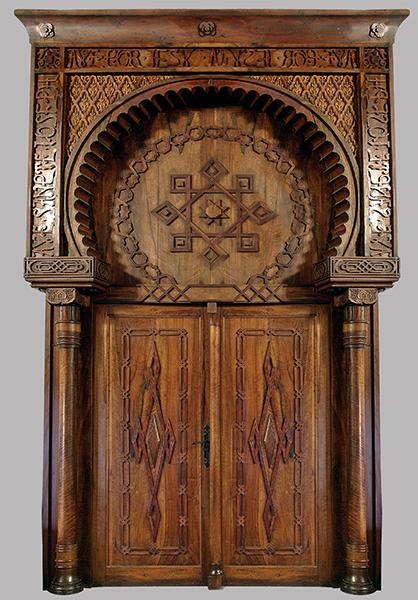Artworks
Ferdinand the Catholic
Description
Sculpture-in-the-round in plaster, polychromed with a greenish patina imitating bronze hues. This is a full-length representation of Ferdinand the Catholic (Ferdinand II of Aragon). It features elements that are typically associated with him, such as the crown framing his long hair, the armour, the full cloak tied at the neck, the royal sceptre in his right hand, and a sword in his left.
The ceremonial collar of the Order of the Golden Fleece hangs across his chest. This emblem was introduced to the Spanish monarchy by Charles V, but had been previously bestowed on others: John II of Aragon, Alfonso V of Aragon, and Ferdinand the Catholic.
Worthy of particular note are certain technical details such as the imprinted decoration on his armour, his crown and hair, and the slight contrapposto that lends a certain movement to the figure. The piece rests on a square plaster block of the same polychrome appearance as the sculpture itself. In its current location, the work is displayed on a large granite pedestal.
In terms of iconography, the artists appear to have drawn inspiration from the attributes of Ferdinand the Catholic as depicted on his carved marble tomb in the Royal Chapel. This latter carving, on the sepulchre, appears alongside that of his wife, Queen Isabella I of Castile, who lies to his right.
History of the piece
Both sculptures are copies of the effigies of the Catholic Monarchs produced by brothers Miguel and Antonio Marín Torres for the Provincial Exhibition of Fine Arts, Industry and Agriculture. The event was organised on the occasion of the visit of Queen Isabella II to Granada, in 1862. The works were awarded the gold medal in their category. Their originals now belong to the heritage collection of Granada City Council.
Replicas of the two sculptures were specially made to go on display in the Arrayanes Courtyard during the gala dinner in honour of Isabella II, and were subsequently transferred to the premises of the Granada Provincial Government, which had organized the Fine Arts Exhibition. Finally, they were relocated to the Hospital Real Rectorate building, where they were discovered in storage in around 1980. It was at this point that the figures were placed in their present location.
Both sculptures were restored in 2017.
Details
- Title: Ferdinand the Catholic
- Category: Esculturas de bulto redondo
- University: University of Granada
- Authors: Marín Torres, Antonio, Marín Torres, Miguel
- Chronology: 1862
- Technique: Polychrome plaster
- Dimensions: 189 x 70 x 90cm
- Stock number: 0003
- Location: Hospital Real
Bibliography
COS-GAYÓN, Fernando (1863). Crónica del viaje de sus majestades y altezas reales a Andalucía y Murcia en setiembre y octubre de 1862. Madrid: Imprenta Nacional.
CUENCA, Francisco (1923). Museo de pintores y escultores andaluces contemporáneos. La Habana: Rambla y Bouza.
OSSORIO Y BERNARD, Manuel (1975). Galería biográfica de artistas españoles del siglo XIX (1883-1884). Madrid: Giner.
Programa de las fiestas reales que han de celebrarse en Granada con motivo del viaje de S.M. la Reina Dª Isabel II y su augusta real familia a esta capital. Granada: Imprenta de D. Francisco Ventura y Sabatel, 1862. Documento firmado por el Alcalde de Granada y el Gobernador de la provincia en el que se explicita la organización de fastos con objeto de la visita de la Reina Isabel II a Granada. Available in Spanish at:
http://digibug.ugr.es/bitstream/10481/25097/1/C019053-41.pdf
Share
Related Artworks
Isabella I of Castile (Isabella the Catholic)
Antonio Marín Torres
UGR
Hospital Real


 EN
EN  ES
ES 




